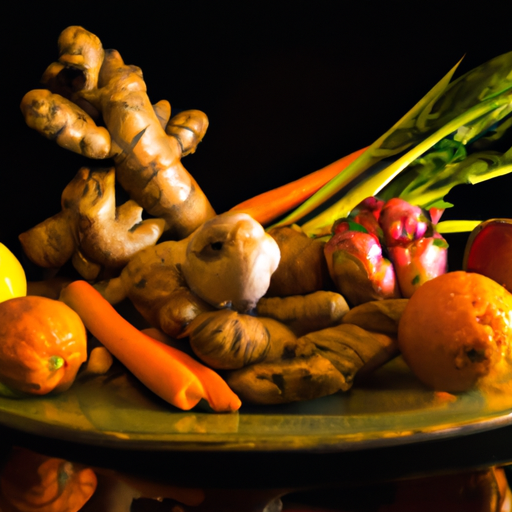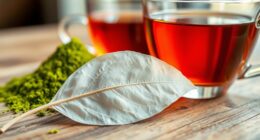So, you want to add some excitement to your tea routine, huh? Well, turmeric powder is the answer. Yes, the spice frequently found in Indian dishes can also be utilized to create a tasty and beneficial tea. And no, we’re not kidding – turmeric tea has been enjoyed for ages due to its health benefits and distinct taste.
But don’t take our word for it, let’s dive into the benefits of drinking turmeric tea and how to make it using turmeric powder. Not only does this tea have anti-inflammatory and antioxidant properties, but it also may help improve brain function and reduce the risk of heart disease and cancer. Plus, it’s a tasty alternative to your usual cup of tea or coffee.
So, grab your turmeric powder and let’s get brewing!
Key Takeaways
- Turmeric powder can be used to make a healthy and flavorful tea, as well as other beverages like turmeric lattes and smoothies.
- Turmeric tea has anti-inflammatory and antioxidant properties, which may help improve brain function, reduce the risk of heart disease and cancer, and aid in weight loss.
- Adding other ingredients like honey, ginger, lemon, or black pepper can enhance the flavor and provide additional health benefits.
- It’s important to consult with a healthcare provider before adding turmeric to your diet, as too much consumption can lead to negative side effects like an upset stomach.
Benefits of Drinking Turmeric Tea
Sipping on a warm cup of turmeric tea can provide numerous benefits for your health. Turmeric has anti-inflammatory properties that can help reduce inflammation throughout your body, from joint pain to digestive issues. This powerful spice can even help boost your immune system, making you less susceptible to illnesses and infections.
In addition to its anti-inflammatory and immune-boosting properties, turmeric tea is also known to aid in digestion and improve brain function. It contains antioxidants that can help protect your body from free radical damage, which can contribute to aging and disease. So, if you’re looking for a natural way to improve your health, turmeric tea may be just what you need. And the best part? It’s easy to make using turmeric powder!
Using Turmeric Powder for Tea
Adding a pinch of the warm, golden spice to a steaming mug of hot water and milk creates a comforting and aromatic beverage. Turmeric powder, with its earthy and slightly bitter taste, can be used to make a variety of beverages including turmeric lattes and smoothies. Incorporating turmeric powder into your daily routine can provide numerous health benefits such as reducing inflammation, boosting immunity, and aiding in digestion.
To make a turmeric latte, simply heat up your milk of choice and add a teaspoon of turmeric powder. You can also add other spices such as cinnamon or ginger for added flavor. For a turmeric smoothie, blend together frozen fruit, milk, and a teaspoon of turmeric powder. This is a great way to incorporate turmeric into your diet and reap its many benefits.
Now that you know how to incorporate turmeric powder into your beverages, let’s dive into the process of making turmeric tea.
Making Turmeric Tea
Get ready to experience a warm and soothing beverage that can provide numerous health benefits with just a few simple ingredients. Making turmeric tea is easier than you might think. There are several variations of turmeric tea you can try, but the basic recipe involves boiling water and adding turmeric powder.
You can also add other ingredients such as honey, ginger, lemon, or black pepper to enhance the flavor and health benefits. One of the most significant health benefits of turmeric tea is its ability to aid in weight loss. The curcumin in turmeric can help reduce inflammation and oxidative stress, which can contribute to weight gain.
Turmeric tea can also help improve digestion and metabolism, which can further aid in weight loss. Additionally, turmeric has antioxidant and anti-inflammatory properties that can protect against chronic diseases such as heart disease and cancer. If you’re looking to add more flavor to your turmeric tea, there are several ways to do so.
You can add a pinch of cinnamon or cardamom for a warm and spicy flavor. Fresh mint or basil can provide a refreshing twist. Experiment with different ingredients and find the combination that suits your taste buds best.
Adding Flavor to Turmeric Tea
To enhance the flavor of your turmeric-infused beverage, try experimenting with different complementary ingredients like fresh mint or basil for a refreshing twist. Here are three options to consider when adding flavor to your turmeric tea:
-
Lemon and honey: A classic combination that adds a sweet and tangy flavor to your tea. Squeeze a wedge of lemon into your cup and stir in a teaspoon of honey for a deliciously balanced taste.
-
Ginger and cinnamon: These warming spices pair well with turmeric to create a cozy and comforting drink. Add a few slices of fresh ginger and a sprinkle of cinnamon to your tea for a spicy kick.
-
Herbal tea blends: Mix things up by adding other herbal teas to your turmeric base. Chamomile, lavender, and peppermint are all great options that can help to promote relaxation and ease digestion.
Now that you know how to add some extra flavor to your turmeric tea, let’s move on to some tips for drinking it.
Tips for Drinking Turmeric Tea
When sipping on your golden elixir, remember to take it slow and savor the flavor, letting the warmth of the tea spread through your body like the sun on a chilly morning. Turmeric tea has possible health effects, such as reducing inflammation, improving brain function, and lowering the risk of heart disease. However, it’s important to note that the recommended dosage is no more than 500-2000mg of curcumin per day, which is the active ingredient in turmeric.
Drinking too much turmeric tea can lead to an upset stomach or other negative side effects. The best time to drink turmeric tea is in the morning or before bed to help with digestion and relaxation. To get the most out of your turmeric tea, store it in an airtight container in a cool, dry place away from direct sunlight. This will help maintain its flavor and potency.
As you move onto the next section about potential side effects, remember to be mindful of the amount of turmeric tea you consume to avoid any negative effects.
Potential Side Effects
Be careful not to overdo it on the golden elixir, as consuming too much of it can lead to digestive issues and other negative side effects. While turmeric is generally safe for consumption, it’s important to monitor your intake and be aware of any potential allergies you may have.
Here are some potential side effects of consuming too much turmeric powder in your tea:
- Upset stomach or nausea
- Diarrhea
- Headaches
- Skin irritation or rash
- Increased risk of bleeding
It’s important to consult with your healthcare provider before adding turmeric to your diet, especially if you have any pre-existing medical conditions or are taking medications that may interact with turmeric.
Now, let’s move on to some delicious turmeric tea recipes.
Turmeric Tea Recipes
Get ready to spice up your afternoon with a cup of warm, aromatic turmeric tea that has been gaining popularity in recent years. A study conducted by the National Institute of Health revealed that curcumin, a compound found in turmeric, has anti-inflammatory properties that can help with joint pain and arthritis. But did you know that there are different ways to prepare turmeric tea? Two popular variations are turmeric latte and turmeric ginger tea.
| Turmeric Latte | Turmeric Ginger Tea |
|---|---|
| Made with milk or a milk alternative | Made with freshly grated ginger |
| Often includes cinnamon or other spices | Can be sweetened with honey or maple syrup |
| Served as a hot or iced latte | Served hot with a slice of lemon |
Turmeric latte, also known as golden milk, is a creamy and comforting drink that is perfect for chilly days. It is often made with milk or a milk alternative and flavored with cinnamon or other spices. On the other hand, turmeric ginger tea is a spicy and invigorating beverage that is made with freshly grated ginger. It can be sweetened with honey or maple syrup and served hot with a slice of lemon. Whether you prefer a cozy latte or a zesty tea, turmeric is a versatile ingredient that can be enjoyed in many different ways.
Now that you know how to prepare turmeric tea, let’s explore additional resources and references to learn more about the benefits and potential side effects of this popular spice.
Additional Resources and References
Don’t forget to do your research and consult with a healthcare professional before incorporating turmeric into your diet, as there may be potential interactions with certain medications or health conditions. However, if you’re looking for a natural way to boost your overall health, turmeric tea may be a great option.
Turmeric tea is known for its anti-inflammatory and antioxidant properties, which can help reduce inflammation in the body and protect against oxidative damage. It may also aid in digestion, support brain health, and improve heart health.
While turmeric supplements are also available, drinking turmeric tea allows for the added benefits of hydration and relaxation. So, next time you’re in the mood for a warm beverage, consider brewing a cup of turmeric tea for a natural boost to your health.
Additional resources and references
Frequently Asked Questions
Are there any specific health conditions that turmeric tea can help with?
Turmeric tea benefits include reducing inflammation, improving brain function, and lowering the risk of heart disease. Turmeric tea recipes are easy to make with turmeric powder, ginger, honey, and hot water. Consult a healthcare provider before using for specific health conditions.
Can you add honey or other sweeteners to turmeric tea?
Yes, you can add honey or other sweeteners to turmeric tea. However, it’s important to note that turmeric tea already has numerous health benefits, including reducing inflammation and improving brain function.
Is it safe to consume turmeric tea while pregnant or breastfeeding?
It’s generally safe to consume turmeric tea during pregnancy and while breastfeeding, but in moderation. However, it’s best to consult with your healthcare provider first to ensure it’s safe for you and your baby.
How much turmeric powder should be used to make one cup of turmeric tea?
Brewing a cup of turmeric tea requires a teaspoon of turmeric powder, but the benefits are worth it. This turmeric tea recipe is a golden elixir that can improve digestion, boost immunity, and reduce inflammation.
Can turmeric tea be consumed cold or does it have to be consumed hot?
Turmeric tea can be consumed cold or hot, depending on your taste preferences. Cold consumption may alter the flavor slightly, but it is still beneficial for health. There is no need to limit yourself to just one way of enjoying turmeric tea.
Conclusion
Congratulations, now you know that using turmeric powder for tea is a great way to enjoy the many benefits of this superfood.
As a natural anti-inflammatory and antioxidant, turmeric can help improve digestion, boost immunity, and even reduce the risk of chronic diseases.
To make your own turmeric tea, simply mix a teaspoon of turmeric powder with hot water and add your favorite flavors like ginger, honey, and lemon.
Remember to drink turmeric tea in moderation and pay attention to any potential side effects such as nausea or stomach upset.
In conclusion, incorporating turmeric tea into your daily routine can be a simple and effective way to support your overall health and wellbeing.
So why not give it a try and see how you feel? Who knows, you may just discover a new favorite drink that not only tastes great but also benefits your body.










